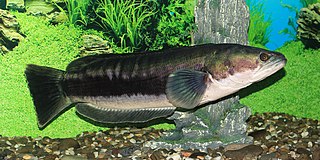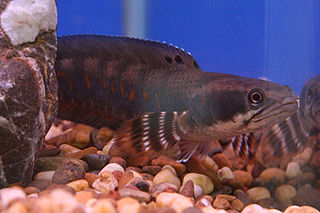
The northern snakehead is a species of snakehead fish native to China, Russia, North Korea, and South Korea, ranging from the Amur River to Hainan. It has been introduced to other regions, where it is considered invasive. In Europe, the first report of the species was from Czechoslovakia in 1956. In the United States, the fish is considered to be a highly invasive species.

Channa is a genus of predatory fish in the family Channidae, commonly known as snakeheads, native to freshwater habitats in Asia. This genus contains about 50 scientifically described species. The genus has a wide natural distribution extending from Iraq in the west, to Indonesia and China in the east, and parts of Siberia in the Far East. A particularly high richness of species exists in Myanmar (Burma) and northeastern India, and many Channa species live nowhere else. In contrast, a few widespread species have been introduced to several regions outside their natural range, where they often become invasive. The large and medium-sized Channa species are among the most common staple food fish in several Asian countries, and they are extensively cultured. Apart from their importance as a food fish, snakeheads are consumed in some regions as a traditional medicine for wound healing and reducing postoperative pain and discomfort, and collected for the international aquarium pet trade.

The snakeheads are members of the freshwater perciform fish family Channidae, native to parts of Africa and Asia. These elongated, predatory fish are distinguished by their long dorsal fins, large mouths, and shiny teeth. They breathe air with gills, which allows them to migrate short distances over land. They have suprabranchial organs, which are primitive forms of labyrinth organs, that develop when they grow older. The two extant genera are Channa in Asia and Parachanna in Africa, consisting of more than 50 species.

The Barca snakehead is a rare species of snakehead. It is endemic to the upper Brahmaputra river basin in northeastern India and Bangladesh. Records from Nepal are of doubtful validity. Overall it has been assessed as data deficient by the IUCN, and in 2014 it was assessed as critically endangered in Bangladesh by the IUCN. In Assam, it is locally known as cheng garaka or garaka cheng.

Channa bleheri is a species of dwarf snakehead that is endemic to the Brahmaputra River basin in the Indian states of Assam and Arunachal Pradesh. It is among the most colorful species of snakehead.

The forest snakehead is a species of snakehead, a fish of the family Channidae. Its range includes most of Southeast Asia and parts of southern China. It lives in forest streams and can reach 40 cm (16 in) in length. The forest snakehead is known in Thai language as pla krasong. Khmer language called it កញ្ជនជៃ, Indonesians named it kehung, while in Malaysia, they called it ikan bujuk in Malay Language

Channa gachua, the dwarf snakehead, is a species of fish in the family Channidae. The name "dwarf snakehead" is also used for several other species of small snakeheads. C. gachua is native to freshwater habitats in southern Asia, where it has a wide distribution from Iran to Indonesia. This fish is considered to be a species complex, a group of several closely related taxa with one name. It is likely at least three to four different species, and further research may differentiate them. A few species such as Channa harcourtbutleri have been separated from the complex in recent decades. The easternmost population of C. gachua is often recognized as a separate species C. limbata, while the isolated Sri Lankan population often is recognized as C. kelaartii.

Channa striata, the striped snakehead, is a species of snakehead fish. It is also known as the common snakehead, chevron snakehead, or snakehead murrel and generally referred simply as mudfish. It is native to South and Southeast Asia, and has been introduced to some Pacific Islands. Reports from Madagascar and Hawaii are misidentifications of C. maculata.

The orange-spotted snakehead is a species of snakehead fish. Its body is of brownish colour intermixed with vertical orange stripes. Males have taller dorsal fins with more intense coloration, and narrower heads. It is endemic to Brahmaputra River basin. Its type locality is Dibrugarh, the most northeastern area of Assam, India. Dibrughar is the same type locality as that of Channa bleheri.
Channa harcourtbutleri, the Burmese snakehead, is a species of snakehead endemic to Inle Lake and surroundings in Myanmar. Locally called nga ohn-ma, among aquarists it is considered one of the dwarf snakeheads, but no significant import for aquarists is known. It is one of the smaller species of snakehead and has a standard length of up to 19.4 cm (7.6 in). The specific name honors Sir Harcourt Butler, a British governor in the region.

Channa micropeltes, giant snakehead, giant mudfish or toman harimau, is among the largest species in the family Channidae, capable of growing to 1.5 m (4.9 ft) in length and a weight of 20 kg (44 lb). It is native to the fresh waters of Southeast Asia, but has also been introduced elsewhere and is considered invasive in Taiwan. Other names include xal mas in Assamese, red snakehead, redline snakehead, and ikan toman.

The King George whiting, also known as the spotted whiting or spotted sillago, is a coastal marine fish of the smelt-whitings family Sillaginidae. The King George whiting is endemic to Australia, inhabiting the south coast of the country from Jurien Bay, Western Australia to Botany Bay, New South Wales in the east. The King George whiting is the only member of the genus Sillaginodes and the largest member of the smelt-whiting family Sillaginidae, growing to a length of 80 cm and 4.8 kg in weight. The species is readily distinguishable from other Australian whitings by its unique pattern of spots, as well as its highly elongate shape. King George whiting are often found in bays and protected waterways over sand and seagrass beds, also venturing out onto deep continental shelf reefs during adulthood. The species is a benthic carnivore, consuming a variety of crustaceans, polychaete worms, molluscs and fish. The King George whiting forms the basis of one of southern Australia's most important commercial fisheries, reportedly worth over five million Australian dollars per year. The species is also heavily targeted by recreational anglers, who value the whiting for its sporting and eating qualities.

The Ceylon snakehead is a species of snakehead found in freshwater habitats, typically shaded streams, in southwestern Sri Lanka.

Pogonoperca punctata, the spotted soapfish, bearded soapfish or leaflip grouper is a species of marine ray-finned fish, related to the groupers and classified within the subfamily Epinephelinae of the family Serranidae. It is found in the western Indo-Pacific region.
The black snakehead is a species of snakehead native to Thailand, Indonesia, Malaysia, Philippines, and Singapore. This commercially important species reaches a length of 30 cm (12 in). The Black Snakehead inhabits large to medium rivers that consists of acidic water and submerged roots. The Black Snakehead feeds on small animals and harmless to humans beings. Snakehead fish have long, slender bodies with long dorsal and butt-centric balances. They have an extensive mouth and distending jaw with canine-like teeth. ]
Rhinophis punctatus, or Müller's earth snake, is a species of snake in the Uropeltidae family. It is endemic to the island of Sri Lanka.

The spotted sunfish, also known as a stumpknocker, is a member of the freshwater sunfish family Centrarchidae and order perciformes. The redspotted sunfish, redear sunfish and pumpkinseed sunfish are its closest relatives. Lepomis punctatus is olive-green to brown in color with black to reddish spots at the base of each scale that form rows of dots on the side. The scientific name punctatus refers to this spotted pattern. It was first described in 1831 by Valenciennes.

Herklotsichthys punctatus, the spotback herring or spotted herring, is a species of herring from the family Clupeidae. Is is endemic to the Red Sea and likely entered the Mediterranean Sea via the Suez Canal and is now common on the Levantine Basin.

Channa pulchra is a species of snakehead fish in the family Channidae which is native to Myanmar. It was first described in 2007 by R. Britz from a specimen collected from the Kyeintali Chaung (stream) basin in Rakhine Yoma, western Myanmar. The fish is found in streams that are fast flowing, clear, highly oxygenated and relatively cold (subtropical). It is of little food value but getting popularity as an aquarium fish recently.

The spotted flathead is a species of marine ray-finned fish belonging to the family Platycephalidae, the flatheads. It is found in the Indo-Pacific.

















